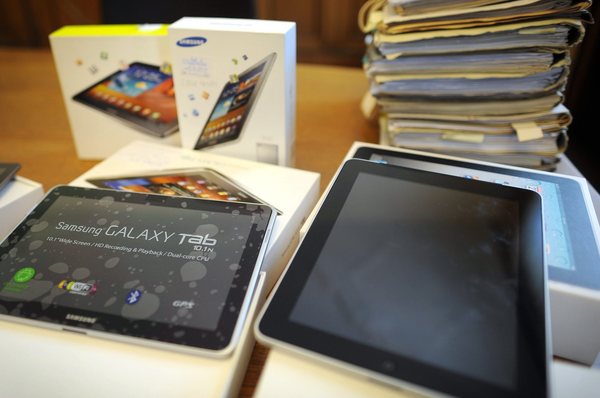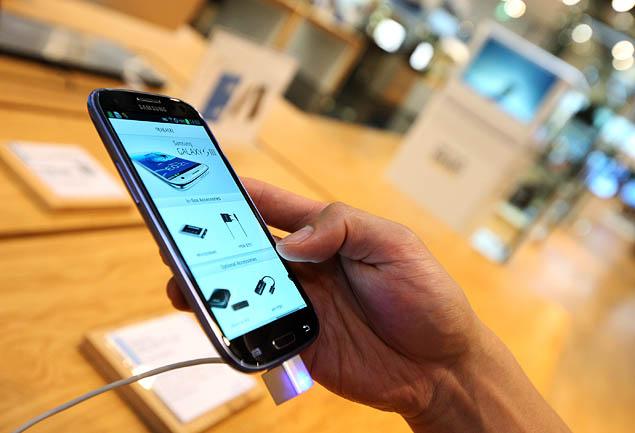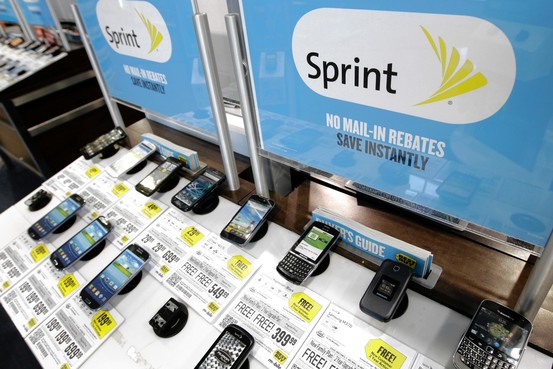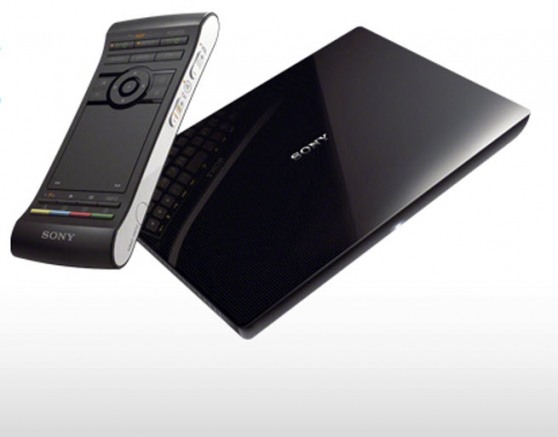Google Earth's 3D imagery now available on iPad, iPhone
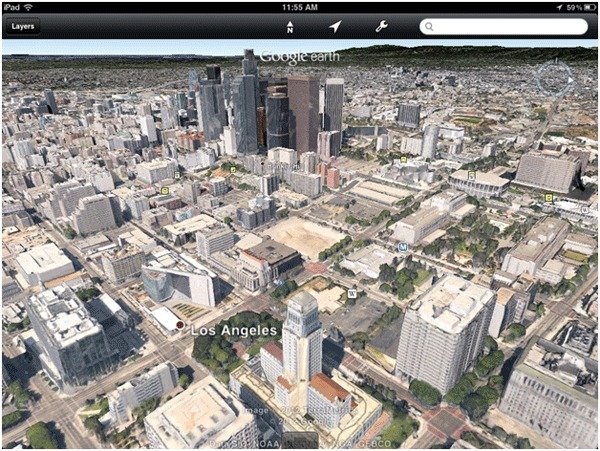
By Deborah Netburn
Toshiba Qosmio G35 Battery + Toshiba Qosmio G45 Battery + Toshiba Qosmio G40 Battery + Toshiba Qosmio F30 Battery + Toshiba Qosmio G50 Battery + Toshiba PA3475U-1BAS Battery + Toshiba Satellite A60 Battery + Toshiba Satellite Pro A60 Battery + Toshiba PA3382U-1BRS Battery +
Google Earth's 3D imagery is now available for the iDevices. Or at least some of them. If you have an iPad 2, an iPhone 4S or the latest iPod touch, then you can enjoy swooping virtually through detailed 3D landscapes, like the one of downtown Los Angeles pictured above.
Android users have been able to use this feature since late June, but the 3D maps were just made available to Apple users on Thursday.
To create the maps, Google uses chartered planes that snap aerial images of every street and structure in major cities from different angles, The Times reported in early June.
So far, about a dozen cities have received the Google Earth 3D map treatment, including Boulder, Colo.; Boston; Charlotte, N.C.; Los Angeles; Portland, Ore.; the San Francisco Bay Area; and Santa Cruz. Rome is the only city on the list that is not in the United States.
Google plans to keep building and releasing 3D imagery for new cities, and by the end of the year, the company hopes to have covered metropolitan areas with a combined population of 300 million people, it wrote in a blog post about Thursday's release of 3D imagery for Apple devices.
Apple users can also access a "tour guide" feature that suggests interesting places to poke on Google Earth.
To access these tours, just pull up the tab at the bottom of the screen and open tour guide. Choose a place you'd like to visit and Google will "fly" you there. Bits of Wikipedia trivia will provide additional information and context about the place you are virtually visiting.
The tour guide is available for all iOS devices running iOS 4.2 and newer.
One bummer? The 3D maps are not available on desktops. At least, not yet.
Control Xbox with an iPhone - Apple patent reveals universal controller app
Proposed iPhone software could mimic Xbox/PS controllers
By Mike Jackson for CVG UK
Apple looks to be considering turning iPhone into a universal controller that would not only be able to operate Apple devices like Macs and Apple TV, but even your games consoles.
The patent clearly shows an iPhone being used to take control of an Xbox 360, as well as various home entertainment devices, as you would expect from a universal controller.
But more interestingly, it also shows the potential for the theoretical app to be programmable via a direct connection with an existing controller - such as a PS3 controller.
Some internet reports have interpreted the image (pictured right) as a proposal for new video game controller from Apple, but we believe it's actually demonstrating the proposed iPhone app's ability to connect with a game controller such as a DualShock (PS3) controller for calibration purposes, which would then allow it to control a PS3 - or any device related to a particular controller - as though it were the native controller belonging to that device.
Toshiba PABAS052 Battery + Toshiba PA3384U-1BRS Battery + Toshiba PA3384U-1BAS Battery + Toshiba PA3382U-1BAS Battery + Toshiba Satellite A65 Battery + Toshiba Satellite M40X Battery + Toshiba Satellite M35X Battery + Toshiba PA3421U-1BRS Battery + Toshiba Satellite M30X Battery +
The patent brief clearly describes the software's ability to "[receive] control information associated with a controllable electronic device via near field communication, determining a control scheme for controlling the controllable electronic device based on the control information, and controlling the controllable electronic device using the determined control scheme."
The question is, would you like to operate your Xbox with an iPhone?
Burn Your iPhone With Chinese Olympic Uniforms
By William Pesek
Tonight, as American athletes enter London's Olympic Stadium, all eyes will be on China. More to the point, on the made-in-China uniforms Team USA is sporting.
Reports that Ralph Lauren Corp. (RL) outsourced production of the uniforms to China has U.S. lawmakers in a lather. Senate Majority Leader Harry Reid said the outfits should be put in a pile and burned. A new bill, the "Team USA Made in America Act," ensures athletes' attire is more politically correct for the 2014 Winter Games, which fittingly will be in Russia.
This controversy is so contrived it hurts: It's nothing more than a ready-made excuse to beat up on that economic bogeyman, China, which replaces the Soviet threat of old in a U.S. election year. Uniform-gate is just a preview of how ugly things may get and, frankly, pointless.
President Barack Obama is under pressure to explain why unemployment is still higher than 8 percent ahead of the Nov. 6 election. Mitt Romney, his Republican challenger, must offer a vision for creating millions of jobs. Expect China to come up early and often as both men try to whip up emotions and support. Wouldn't it be better if each offered specific ways to revitalize the U.S. job market, perhaps even with China's help?
Shallow Politics
These shallow politics of the moment trivialize the most important relationship in the world and the magnitude of the real strains. The Obama and Romney teams should be brainstorming about ways to correct the global imbalances that thwart America's recovery. Xi Jinping, the man in line to be China's next president, should be telegraphing a new direction for a lopsided economy that so far can only thrive by pursuing zero- sum trade policies.
Instead, the U.S. and China are wasting time assigning blame and hoping globalization's biggest challenges work themselves out. The leadership in both countries that might develop and promote a rebalancing is nowhere in sight.
The uniforms episode reminds us that the U.S. is engaging in fatuous pandering. Consider the lack of outrage over Roots Canada Ltd., the Toronto-based company that made U.S.-team duds for the 2002 Salt Lake City Games (headed by Romney) and for Athens in 2004.
The difference is that Americans don't view Canada as a rival that threatens U.S. primacy. The U.S. doesn't fear Canada when it comes to exchange rates, cheap labor, human-rights records, military buildups, support of repressive regimes, designs on conquering space or massive stockpiles of Treasuries; that distinction is all China's.
Toshiba PA3395U-1BRS Battery + Toshiba Satellite Pro M40X Battery + Toshiba Equium L20 Battery + Toshiba Tecra L2 Battery + Toshiba PA3506U-1BRS Battery + Toshiba Satellite L20 Battery + Toshiba Satellite L100 Battery + Toshiba PA3450U-1BRS Battery + Toshiba Satellite L10 Battery
Yet it's hypocrisy to blame China for the U.S.'s woes. Apple Inc. probably could assemble its iPhones and iPads within driving distance of headquarters in Cupertino, California, where it dreams up these gadgets. It makes them in Shenzhen sweatshops for reasons that have more to do with the U.S. economy than China's. U.S. consumers want bargains; shareholders demand that Apple produce its goods as cheaply as possible; Americans insist on high-paying jobs, and U.S. laws prohibit China-level wages.
Consumers would be shocked to learn how many of the American flags they fly are made in China. Ditto for the Louisville Slugger baseball bats they buy for their kids and the fireworks that cities use to celebrate Independence Day. Yet these eight words explain the pros and cons of globalization: "Designed by Apple in California, Assembled in China." They show why even high-tech products invented in the U.S. don't increase exports, but rather exacerbate the nation's trade deficit.
America's Capitalism
Sure, China should let its currency appreciate. Yes, it cheats on trade. Intellectual-property rights still mean little to officials in Beijing. An equally big dilemma is the direction American-style capitalism has taken during the past 20 years. The only way to reverse things is for Apple and other icons of U.S. industry to begin producing at home. And for most products, that's not about to happen, given the vast gap between U.S. and Chinese labor costs.
Looked at this way, Ralph Lauren is only doing what U.S. politicians, by way of government policies, encourage it to. Executives who denounce Obama as anti-business while gleefully pumping up profits produced abroad and squirreling away cash in tax havens should look in the mirror as they decry the lack of household demand since the 2008 financial crisis.
The U.S. doesn't have a monopoly on hypocrisy. China is indignant over the Team USA uniform uproar; the official Xinhua News Agency calls it "a blasphemy" on the Olympic spirit. Come on, the commercialization of the games and the corruption scandals that plague the International Olympic Committee should disabuse us of that. The Summer Games is "American Idol" with sneakers. And although it may shock many in China, plenty of the U.S.'s gripes are legitimate.
Devising smart policies will yield better results for the U.S. than bashing China. Striking free-trade agreements around the globe would do more good than waiting for the yuan to strengthen. So will looking for new markets. So will reviving the entrepreneurial passion that made the U.S. economy No. 1.
The key is to find ways to keep more of the jobs that some of the world's most dynamic companies create at home. Bellyaching over who dresses Team USA won't get America onto the medal podium.
Facebook Is Said to Work With HTC on Mobile Phone for Mid-2013
By Tim Culpan
Facebook Inc. (FB) (FB), owner of the largest social network, is working with HTC Corp. to build its own smartphone for release as soon as mid-2013, people with knowledge of the matter said.
The companies had intended to release the device as early as the end of this year, and pushed back the timetable to give HTC more time to work on other products, said some of the people, who requested anonymity because the plans aren't public. Facebook is also developing a modified operating system for the device and has assembled a team of former Apple Inc. (AAPL) (AAPL) programmers to improve its iPhone application, people said.
Toshiba Satellite Pro L10 Battery + Toshiba Satellite L25 Battery + Toshiba Satellite Pro L20 Battery + Toshiba Satellite L35 Battery + Toshiba PABAS059 Battery + Toshiba Satellite Pro L100 Battery + Toshiba PA3420U-1BRS Battery + Toshiba PA3420U-1BAC Battery + Toshiba PA3420U-1BAS Battery +
More than half of Facebook's 900 million users access the social network via mobile devices, while none of the $3.15 billion in advertising sales last year came from ads on phones. Chief Executive Officer Mark Zuckerberg could use a Facebook phone, with social-networking features built-in, to woo marketers and assuage concerns dragging on the company's shares.
"Usage is shifting to mobile, and they have not been able to monetize mobile," said Victor Anthony, an analyst at Topeka Capital Markets Inc. "To the extent that it's a device you own and carry around with you at all times, and it ties into the Facebook experience, it will be beneficial. They could then put a lot of ads onto the platform."
Sally Julien, a spokeswoman for Taoyuan, Taiwan-based HTC (2498), declined to comment.
Mobile Growth
Facebook stock has tumbled 23 percent since its initial public offering on May 17. The decline came in part due to concerns that the company isn't making enough money from mobile advertisers. The stock climbed 3.1 percent to $29.34 as of the close yesterday in New York.
"Our mobile strategy is simple: We think every mobile device is better if it is deeply social," Menlo Park, California-based Facebook said in a statement. "We're working across the entire mobile industry; with operators, hardware manufacturers, OS providers, and application developers to bring powerful social experiences to more people around the world."
Former Apple staff hired by Facebook to work on mobile are: Greg Novick, who helped develop the touch-screen user interface; Tim Omernick and Chris Tremblay, who also worked on the device's software; and Scott Goodson, who helped create the stock-market application, according to people with knowledge of the hires.
Last year, Facebook also bought Push Pop Press, a digital publishing software maker co-founded by Apple alumni Mike Matas and Kimon Tsinteris, two designers who helped build the look and feel of the iPhone and iPad software. Matas is credited with creating the battery logo that shows on the iPhone screen when it's charging. A longtime BlackBerry user, Mark Zuckerberg converted to an iPhone in the past couple of years.
IPhone App
This team from Apple has been primarily focused on rebuilding Facebook's iPhone application, which has been criticized by users for being slow. An initial release could be announced within a couple of months, with another broader overhaul of the iPhone app coming next near, one person said.
The company also hired several key staffers who worked on the Palm operating system for mobile phones.
Zuckerberg said earlier this month that bringing Facebook's features to handheld gadgets was difficult because the user experience is so different than on desktop computers.
Asked in an interview at the Allen & Co. media conference in Sun Valley, Idaho, about his greatest challenge right now, Zuckerberg said it was "the shift to mobile."
The New York Times reported in May that Facebook had hired a team of former Apple engineers with the goal of releasing a phone by next year. AllThingsD reported in November that a Facebook phone would debut between late 2012 and mid-2013.
Toshiba Satellite L30 Battery + Toshiba PA2506UR Battery + Toshiba PA3002U-1BRL Battery + Toshiba PA2505UR Battery + Toshiba Portege 7010 Battery + Toshiba PA3001U-1BRM Battery + Toshiba Portege 7020 Battery + Toshiba Portege 7000 Battery + Toshiba PA3002UR Battery +
Mobile Results
Facebook started offering mobile ads in March and hasn't provided statistics on their impact. Facebook has said ad growth won't keep pace with user gains. The company is scheduled to report second-quarter results after the close of trading today.
While Facebook already has applications that run on Apple's iOS devices as well as Google Inc. (GOOG) (GOOG)'s Android mobile operating system, it is looking to embed its features deeper into mobile devices to grow advertising revenue.
While that would put Facebook into direct competition with Apple and Google, it could also help protect Facebook from their influence, said Brian Wieser, senior research analyst at Pivotal Research Group.
"The fear is, Apple might extract a toll from your users," Wieser said. "Apple could tell Facebook, We are making Google+ the default. What is it worth to you to make it otherwise?"
Software Development
Facebook could use a modified version of Android for its smartphone. Android, unlike Apple's iOS, can be modified by mobile phone manufacturers or wireless carriers.
Facebook had been working with mobile device makers such as Britain's INQ Mobile Ltd. to create phones that made it easier to use social websites such as Facebook and Twitter. The new work with HTC will allow for deeper integration of Facebook features, the people said.
HTC and Facebook have collaborated closely before. Last year, HTC began selling "ChaCha," an Android-based phone with a dedicated Facebook button to share music, photos and messages.
Struggling against larger competitors in the U.S., HTC had seen its global smartphone market share shrink to 4.8 percent in the first quarter, down from 8.9 percent the year before, according to IDC.
Shares in HTC have dropped 43 percent this year after it reported three consecutive quarters of profit decline.
Toshiba Portege 7140 Battery + Toshiba PA3000UR Battery + Toshiba Portege 7200 Battery + Toshiba PA3000U-1BRS Battery + Toshiba Portege 7220 Battery + Toshiba Satellite M115 Battery +
